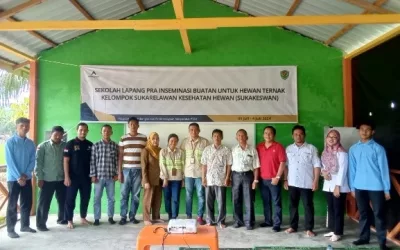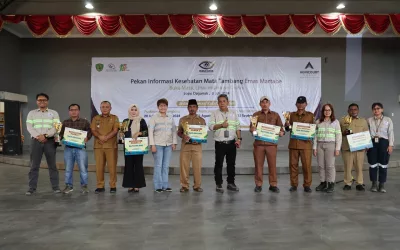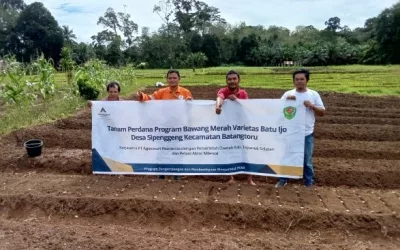People in Sumatra have lived alongside the Sumatran Tiger (Panthera Tigris Sumatrae/Sondaica) for a long time, and greatly respect the king of the jungle, a tradition passed down from their ancestors. This peaceful connection has become part of the life of the people of Aceh, Kerinci, North Sumatra, Minangkabau, and Bengkulu. Customs, dances, folklore full of morals, and self-defence movements are also heavily influenced by the community’s respect for tigers.
Many nicknames are labelled for the Tigers in various regions across Sumatra. In Aceh, tigers are called by the name Rimueng as a form of respect by the people of Aceh, while at the same time, they also believed that Rimueng had mystical values. People in North Sumatra call the tiger by the name “Ompung” or grandfather as their homage to this big cat endemic to Sumatra. In Kerinci the tiger is nicknamed Rimau and is considered sacred. There are still names like Inyiak Belang or Datuk Belang in Minang society as they pay respect to the apex predator in Sumatra.
The sacredness of the inyiak belang, which previously been a respected tradition, is diminishing and sparking the tension between the big cat and humans. Even though the traces of the tiger heritage tradition can still be seen and heard, the level of its sanctity has been hitting the floor. The sacredness of inyiak belang is even further away from customary respect. Now there are many conflicts between humans and tigers (human-tiger conflict). Tigers are hunted and snared, thus creating enmity between the two.
Poachers hunt the tigers as their whole body or body parts like skin, whiskers, claws, or head have now become a precious commodity. Thus raising the imminent and present threat to the survival of the Sumatran tiger population. Tiger hunting is a criminal act and is against the law because it violates Article 21 of Law number 5 of 1990 concerning the Conservation of Living Natural Resources and their Ecosystems. On the black market, tiger parts are sold at IDR 5 million to IDR 25 million per piece. While the fangs are offered starting from IDR 400 thousand to IDR 1.1 million. These tiger parts are usually sold in art shops, precious stone sellers, and traditional medicine sellers underhanded.
PTAR’s Effort to Save the King of the Jungle
The Sumatran tiger is the only remaining and critically endangered Sundanese tiger (Panthera Tigris Sondaica) in the world. With only a few hundred individuals left in the wild, urgent action is needed to ensure their survival. Previously in Indonesia, there were three types of tigers in the Sunda Islands which were considered one genus, they are the Sumatran tiger (Panther Tigris Sumatrae), the Javan tiger (Panthera Tigris Sondaica), and the Bali tiger (Panthera Tigris Balica). The last two species are already extinct.
Currently, it is estimated that there are less than 800 mature individual tiger populations left, scattered throughout Sumatra, especially in protected forests and national parks. Saving the endangered Sumatran tiger requires a multifaceted approach that addresses habitat conservation, anti-poaching efforts, community involvement, and the potential role of zoos and captive breeding programs. I Governments, organizations, and individuals must work together to ensure the survival of this extraordinary species for future generations.
In response to the matter, PTAR established tight cooperation with North Sumatra BKSDA, YPBMM, and Barumun Wildlife Sanctuary, supporting conservation efforts for the last species of tiger still found in Indonesia. With these two conservation agencies, PTAR was involved and gave full support in rescuing Sumatran tigers, which have been trapped in snares meant for deer or wild boars in several places around North Sumatra. The rescued tigers were then brought to the sanctuary to treat the wounds and restore their health. It would take months before the tiger is eligible to be released into the wild again. Veterinarians and experts are involved in monitoring these tigers during their recovery in the sanctuary before the tigers are ready to be released.
The releasing processes were also not simple tasks.
PTAR participated in releasing the tigers back into the wild by providing a helicopter along with its pilots, crews, fuels, and ground support equipment. The release process needs a helicopter to step into a remote and isolated area that can not be reached by humans. The helicopter can go further deep into the forests to ensure the safety of the tigers and keep them out of conflict with humans.
As a company that is fully aware of the value of biodiversity, PTAR knows that these animals play an important role in the balance of the ecosystem as apex predators. Tigers are carnivorous animals that are one of the main predators in the food chain cycle in the Sumatran ecosystem so they also play an important role in maintaining the balance between herbivores and other vegetation in nature. Habitat loss due to land clearing for agriculture, illegal logging, and the massive hunt of their prey can result in reduced populations of tigers making them vulnerable to genetic disorders and jeopardizing their long-term survival.
The shrunken population of Sumatran tigers has a significant impact on the entire ecosystem. These top predators play an important role in maintaining the balance of their habitat. As their numbers decline, populations of prey species, such as deer and wild boar, increase exponentially, causing overgrazing and habitat degradation. After the complete extinction of the Javan and Balinese tigers, PTAR sees this tiger’s conservation as a strategic and high-valued mission since the Sumatran tiger is the only big cat genetic resource owned by Indonesia in terms of germplasm wealth does not exist anywhere else on earth.
PTAR facilitated the release process of Sri Nabila, a female tiger that was unleashed in Gayo Lues, Aceh, 500 km away to the north of the Martabe mine site in November 2020. In July 2022, PTAR was again involved in releasing two tigers, a male tiger named Surya Manggala and a female tiger called Citra Kartini in Kerinci Seblat National Park, Jambi. PTAR provided helicopters to transport the tigers away because they were released in the middle of the forest which is not accessible by land transportation and is close to nowhere from human settlements.
Read Also: Martabe Gold Mine Donates a Vehicle for Animal Rescue of Barumun Sumatran Tigers Sanctuary
President Director of PTAR, Muliady Sutio, stated that PTAR’s support in releasing the Sumatran tiger is part of the company’s commitment to continuing a fundamental, structured, and collaborative environmental management program with all stakeholders.
“We continue to strive to provide benefits for all stakeholders, including in terms of environmental and biodiversity conservation, community empowerment, and environmental health and safety. Sumatran tiger conservation is one of them,” said Muliady.
The Javan and Balinese tigers are ultimately considered different subspecies, with the scientific name Panthera Tigris Sondaica for the Javan tiger and Panthera tigris balica for the Bali tiger which was declared extinct on the IUCN Red List in 2008. Meanwhile, the Sumatran tiger (Panthera tigris Sumatrae) is a subspecies of tiger. A native to the island of Sumatra in Indonesia. They are slightly smaller than their cousin, the Royal Bengal tiger, but are noted for their distinctive dark orange fur and prominent black stripes.
The Sumatran tiger is the smallest among all tiger species in the world but is known as the most aggressive. The color of the fur is very intense or highly saturated with a typical striped density. The Sumatran tiger is good at swimming and is the only tiger in the world that has membranes between its fingers, it is also good at climbing trees and likes to eat durian, this trait is only possessed by the last species of tiger in Indonesia.
Current Population Status
According to recent estimates, the Sumatran tiger population reaches around 800 individuals throughout Sumatra, from Lampung to Aceh. This species is included in the red code on the IUCN or CE (Critically Endangered) list. This number is alarming compared to the thousands who roamed the island a century ago. The rapid decline in their numbers is primarily due to human activities.
The Sumatran tiger once thrived in the lush rainforests of Sumatra, but now its habitat has been reduced to fragmented patches. As these majestic creatures struggle to find enough space to roam and hunt, their chances of survival grow even more severe.
Sumatran tigers face many threats that contribute to their endangered status. Habitat loss due to deforestation, mainly driven by forest conversion for agriculture and logging, has significantly reduced available habitat. Massive land clearing for oil palm plantations, in particular, has been a major driver of deforestation in Sumatra.
Deforestation not only destroys the tiger’s natural habitat but also disrupts its prey base. With the loss of dense forest cover, prey animals have become more vulnerable to predation and poaching, resulting in a decline in their numbers. This dearth of prey further compounded the challenges Sumatran tigers face, pushing them ever closer to the brink of extinction. Illegal hunting carried out by humans for tiger prey animals such as deer, mouse deer, goats, and wild boar has also hampered the increase in the tiger population.
In addition, poaching and hunting for their body parts, which are believed to have medicinal efficacies, are increasingly threatening their existence. The demand for tiger bones, skins, and other body parts in the wildlife underhand trade drives poachers to relentlessly target these extraordinary creatures. Despite efforts to combat poaching, the high demand and lucrative nature of this illicit trade continue to be a significant challenge in conserving the Sumatran tiger population.
Conservation organizations and the government have realized the urgency to protect the Sumatran tiger and its habitat. PTAR together with BBKSDA and related parties are tireless in providing education and understanding to the people around Batang Toru about the importance of protecting protected wild animals, not only the Sumatran tiger, but also other wild animals such as orangutans, tapirs, Sumatran serow (Capricornis sumatraensis), great argus pheasant (Argusianus argus), pangolins and etc.
Efforts are underway to establish protected areas and enforce stricter laws against poaching and illegal logging. However, the road to recovery is long and challenging. Community awareness and support are very important in ensuring the survival of the Sumatran tiger. By understanding the threats they face and the importance of their conservation, PTAR and the community can work together to secure the future for these extraordinary creatures and Sumatra’s rich biodiversity. President Director of PTAR, Muliady Sutio, stated that PTAR’s support in releasing the Sumatran tiger is part of the company’s commitment to continuing a fundamental, structured, and collaborative environmental management program with all stakeholders.







